by Bruce Wells | Jun 30, 2025 | This Week in Petroleum History
June 30, 1864 – Oil Tax funds Civil War –
The federal government taxed oil for the first time when it levied a $1 per barrel tax on production from Pennsylvania oilfields.

Seeking ways to pay for the Civil War, Treasury Secretary Salmon Chase advocated an oil tax of $6.30 per barrel.
Desperate for revenue to fund the Civil War as early as 1862, Treasury Secretary Salmon Chase advocated a $6.30 tax per barrel of oil and $10.50 per barrel on refined products. Angry oil producers rallied against the tax in Oil City, Pennsylvania, and sent delegates to Washington, D.C., where they negotiated a tax of $1 per 42-gallon barrel of oil.
July 1, 1919 – Top Independent Producers associate in Tulsa –
The two-year-old Mid-Continent Oil & Gas Association established its Kansas-Oklahoma Division in boom town Tulsa. Members were a “who’s who” of top independent oil and natural gas producers.

Alf Landon served as Kansas governor and was the 1936 Republican presidential candidate.
Today the U.S. Oil & Gas Association, membership in 1919 included Frank Phillips of Phillips Petroleum; E.W. Marland, whose company became Conoco; W.G. Skelly, founder of Skelly Oil; H.H. Champlin, founder of Champlin Oil; and Alf Landon, the 1936 Republican presidential candidate. Robert Kerr of Kerr-McGee Oil Company presided as president of the Mid-Continent Division from 1935 through 1941.
July 1, 1922 – Smackover Field brings Arkansas Drilling Boom
First settled by French fur trappers in 1844, Smackover, Arkansas, had a population of just 90 people in 1922 when a wildcat well erupted oil. The well, drilled to 2,066 feet by sawmill owner Sidney Umsted, discovered the 25,000-acre Smackover field. Within six months, 1,000 wells were drilled with a success rate of 92 percent.

Roughnecks photographed following the July 1, 1922, discovery of the Smackover (Richardson) field in Union County. Photo courtesy of the Southwest Arkansas Regional Archives.
Smackover’s population grew to 25,000 and its uncommon name quickly attained national attention. Nearby less than two years earlier, the first commercial oil well in Arkansas, the Busey-Armstrong No. 1, had revealed the giant El Dorado field and launched the career of a young H.L. Hunt.
Learn more in First Arkansas Oil Wells.
July 1, 1938 – The Texas Company discovers Illinois Oilfield
Using a newly introduced technology of seismic exploration, petroleum geologists found hidden anticlines with commercial quantities of oil in Marion County, Illinois. By January 1939 the Salem field was ranked seventh in U.S. daily production. In one year the field produced more than 20 million barrels of oil.
Natural gas production in Illinois began as early as 1853 when marsh or “drift gas” was produced from two water wells drilled near Champaign. The state’s first drilling boom arrived in 1906, thanks to the John Shore No. 1 oil well in Crawford County, according to the Illinois Oilfield Museum.
July 2, 1910 – President Taft establishes Naval Petroleum Reserves
As the Navy converted from coal to oil-burning ships, President William Howard Taft established three Naval Petroleum Reserves.

“As a prospective large consumer of oil by reason of the increasing use of fuel oil by the Navy, the federal government is directly concerned both in encouraging rational development and at the same time ensuring the longest possible life to the oil supply,” the president declared in a message to Congress.
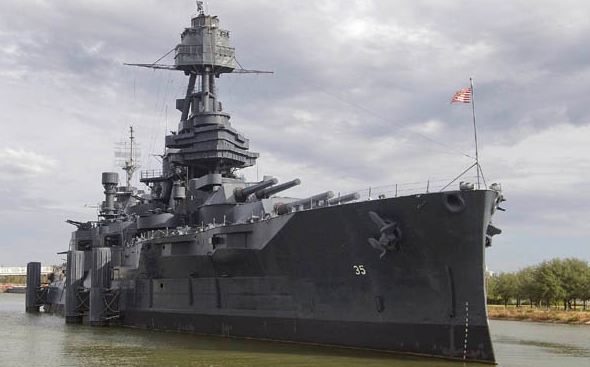
Commissioned in 1914 with coal-powered boilers that were converted to use fuel oil in 1925, the U.S.S. Texas “was the most powerful weapon in the world.”
The last U.S. battleship to be built with coal-fired boilers, the U.S.S. Texas, was launched in 1912 and converted to oil-fired boilers in 1926.
Learn more in Petroleum and Sea Power.
July 2, 1913 – First Gasoline-Electric Hybrid Locomotive
While most U.S. trains were still steam-powered, General Electric built the first commercially successful gasoline-powered engine locomotive. Two General Motors 175-horsepower V-8s powered two 600-volt, direct current generators to propel the 57-ton locomotive to a top speed of 51 miles per hour.
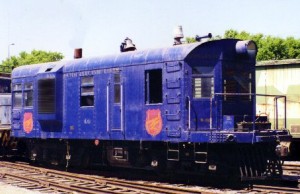
Many consider the locomotive “Dan Patch” the first successful internal combustion engine locomotive in the United States.
The Electric Line of Minnesota Company purchased the new gasoline-powered electric hybrid for $34,500, naming it “Dan Patch” in honor of the world’s champion harness horse of the time. By 1930, diesel engines with G.E. generators launched the modern train industry with Streamliners.
July 2, 1920 – West Columbia Oilfield discovered in Texas
The Abrams No. 1 well erupted oil in Brazoria County, Texas, revealing the West Columbia oilfield southwest of Houston. Drilled by the Texas Company (the future Texaco), the well initially produced up to 30,000 barrels of oil a day. The well was completed on a 1,650-acre tract owned by railroad official William H. Abrams (1843–1926), who administered millions of acres for the Texas Pacific Land Trust.
Abrams also invested in Mitchell County leases in West Texas, where another 1920 wildcat well discovered the first oil production of the Permian Basin. Three years later, drillers from El Paso completed the Santa Rita No. 1 well.
July 5, 1900 – Edison films New Jersey Refinery Fire
An early morning lightning strike at the Standard Oil Company refinery at Bayonne, New Jersey, set off explosions in three storage tanks, each with a capacity of 40,000 barrels of oil. Within minutes, the company’s fire department and tugboats rushed to fight the blaze.

Screenshots from Thomas Edison’s film of the destruction of Standard Oil Company’s refinery at Bayonne, New Jersey, on July 5, 1900, courtesy Library of Congress.
“The tugboats moved the company ships and oil-filled barges away from its burning docks to safe waters,” noted the Jersey Journal in 2017. The Bayonne refinery fire was one of the first newsreels produced by the Thomas A. Edison Company (it can be viewed here). As bad as the conflagration was, there were no fatalities.
July 6, 1988 – Piper Alpha North Sea Tragedy
An explosion and fire on Occidental Petroleum’s Piper Alpha offshore production platform in the North Sea resulted in the deaths of 167 out of 224 personnel. It remains the most deadly offshore disaster in petroleum history.

“Smoke pouring from Piper Alpha throws a pall over the North Sea 18 hours after the explosion,” reported The Daily Telegraph of London on July 8, 1988.
Piper Alpha had been receiving natural gas from two platforms while exporting gas to a compression platform. The initial explosion was caused “by a misunderstanding of the readiness of a gas condensate pump that had been removed from service for maintenance of its pressure safety valve,” according to safety expert Gary Karasek.
Improved offshore platform designs, operations engineering, evacuation technologies, and safety procedures emerged following the official inquiry, noted Karasek. “It was a ground-breaking effort, with numerous detailed findings and 106 recommendations, which were readily accepted by industry.”
_______________________
Recommended Reading: Tulsa Where the Streets Were Paved With Gold – Images of America (2000); The Discovery of Oil in South Arkansas, 1920-1924 (1974); Historic Battleship Texas: The Last Dreadnought
(2000); The Discovery of Oil in South Arkansas, 1920-1924 (1974); Historic Battleship Texas: The Last Dreadnought (2007); Evolution of the American Diesel Locomotive, Railroads Past and Present
(2007); Evolution of the American Diesel Locomotive, Railroads Past and Present (2007); Early Texas Oil: A Photographic History, 1866-1936
(2007); Early Texas Oil: A Photographic History, 1866-1936 (2000) Death and Oil: A True Story of the Piper Alpha Disaster on the North Sea
(2000) Death and Oil: A True Story of the Piper Alpha Disaster on the North Sea (2011). Your Amazon purchase benefits the American Oil & Gas Historical Society. As an Amazon Associate, AOGHS earns a commission from qualifying purchases.
(2011). Your Amazon purchase benefits the American Oil & Gas Historical Society. As an Amazon Associate, AOGHS earns a commission from qualifying purchases.
_______________________
The American Oil & Gas Historical Society (AOGHS) preserves U.S. petroleum history. Please become an AOGHS annual supporter and help maintain this energy education website and expand historical research. For more information, contact bawells@aoghs.org. © 2025 Bruce A. Wells. All rights reserved.
by Bruce Wells | Jun 23, 2025 | This Week in Petroleum History
June 23, 1921 – Signal Hill brings California Oil Boom –
Another southern California drilling boom began when a geyser of “black gold” erupted 114 feet high at Signal Hill. The Alamitos No. 1 well, which revealed a giant oilfield, produced about 600 barrels of oil a day when it was completed.
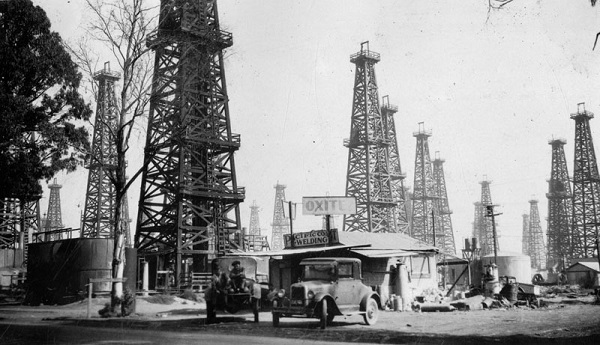
The Signal Hill oil discovery helped make California the source of one-quarter of the world’s oil output. “Porcupine Hill” and the Long Beach field produced 260,000 barrels of oil a day by 1923. Photo courtesy of Los Angeles Museum of Natural History.
Soon known as “Porcupine Hill,” the Signal Hill oilfield 20 miles south of Los Angeles produced almost 260,000 barrels of oil a day by 1923. Combined with the 1892 Los Angeles Oilfield discovery and the 1920 Huntington Beach oilfield, California produced one-fourth of the world’s oil. A monument dedicated in 1952 at Signal Hill’s Discovery Well Park has served “as a tribute to the petroleum pioneers for their success here.”
Learn more in Signal Hill Oil Boom.
June 23, 1947 – Supreme Court limits State Rights to Continental Shelf
The U.S. Supreme Court ruled California could not claim rights to the continental shelf beyond three nautical miles. Litigation resulted from President Harry Truman’s September 1945 Continental Shelf Proclamation, which placed control with the federal government. The Supreme Court ruling on the Truman Proclamation affirmed federal jurisdiction “with respect to the natural resources of the subsoil and seabed of the continental shelf.” Similar rulings affecting Louisiana and Texas would be made in 1950.
June 24, 1937 – Traces of Oil found in Minnesota
In far western Minnesota, a remote wildcat well drilled in Traverse County began producing three barrels of oil a day from a depth of 864 feet. The unlikely discovery prompted more leasing, but no commercial quantities of oil.
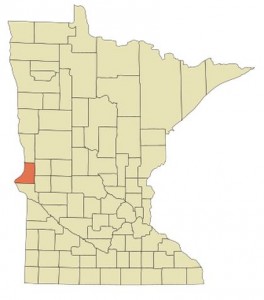
Traverse County, Minnesota, where oil production peaked in 1937.
The lack of an oilfield reaffirmed geologists’ conclusions since 1889 that conditions for significant petroleum deposits did not exist in Minnesota, despite some water wells in southern Minnesota containing small amounts of natural gas.
“Not much oil and gas is obtained from Precambrian rocks, with which Minnesota is very amply blessed,” noted the 1984 book Minnesota’s Geology.
June 25, 1889 – First Oil Tanker catches Fire in California
The first oil tanker built for that purpose, a schooner named W.L. Hardison, burned at its wharf in Ventura, California. The Hardison & Stewart Oil Company (later Union Oil) commissioned the experimental vessel, which offered an alternative to paying for railroad oil tank cars charging one dollar per oil barrel to reach markets in San Francisco.
With oil-fired steam boilers and supplemental sails, the schooner could ship up to 6,500 barrels of oil below deck in specially constructed steel tanks. After the fire, the tanks were recovered and used at the company’s Santa Paula refinery. It took 11 years before the company launched a replacement tanker, the Santa Paula.

Rare photographs of the doomed oil tanker W.L. Hardison and Ventura pier courtesy the Museum of Ventura County.
The Ventura Wharf Company by April 1898 had exported 518,204 barrels of bulk oil during the previous year, according to the Los Angeles Times. The pier remained a working wharf until 1936 when it became the longest recreational wooden pier in California.
Designated a Ventura Historic Landmark in 1976 and now 1,600 feet long, California’s oldest pier was refurbished for $2.2 million in 2000, according to the Museum of Ventura County, which also operates archaeological and agricultural museums. In nearby Santa Paula, the 1890 headquarters building of Union Oil Company is home to the California Oil Museum.
June 25, 1901 – Red Fork Discovery leads to Tulsa Boom
Six years before statehood, Oklahoma witnessed a second oil discovery (some say the third — see Another First Oklahoma Oil Well) when two drillers from the Pennsylvania oil regions discovered an oilfield at Red Fork in the Creek Indian Nation.
John Wick and Jesse Heydrick drilled the Sue A. Bland No. 1 well near the Creek village across the Arkansas River from Tulsa. Sue Bland, a Creek citizen, was the wife of homesteader Dr. John C. W. Bland. Their Red Fork well produced just 10 barrels of oil a day from a depth of 550 feet, but created a drilling boom attracting petroleum companies to nearby Tulsa.
Learn more in Red Fork Gusher.

June 25, 1999 – Texas Post Office named Historic Place
The former U.S. Post Office building in Graham, Texas, with its Great Depression-era oilfield mural by Alexandre Hogue, joined the National Register of Historic Places. Hogue’s 1939 “Oil Fields of Graham” has been joined by other art exhibits in its historic Art Deco building on Third Street.

“Oil Fields of Graham” by Alexandre Hogue, a 1939 mural in the Old Post Office Museum & Art Center of Graham, Texas. The white-haired gentleman was the mayor of Graham.
Hogue’s artwork included many southwestern scenes as part of the New Deal Federal Arts Program. His murals on the walls of public buildings often portrayed scenes of the Texas petroleum industry. In Graham’s historic building on Third Street, “Oil Fields of Graham,” 12 feet wide and 7 feet high, is among exhibits at the Old Post Office Museum & Art Center, which opened in 2002.
Learn more in Oil Art of Graham, Texas.
June 26, 1885 – Natural Gas Utility established in Pennsylvania
Peoples Natural Gas Company incorporated — the first Pennsylvania natural gas company chartered by the state to regulate production, transmission, and distribution of natural gas. A similar utility incorporation had taken place a year earlier in New York City when six competing companies combined to form Consolidated Edison.
By 1891, the Pittsburgh-based limited liability company had consolidated pipelines and facilities of Pittsburgh Natural Gas, Lawrence Natural Gas, Conemaugh Gas, and Columbia Natural Gas companies. More than a dozen more companies would be acquired between 1903 and 1961. The large utility added Saxonburg Heat and Light in 1979 and Equitable Gas in 2017, expanding natural gas services in West Virginia and Kentucky.
June 28, 1887 – Kansans celebrate First Natural Gas Jubilee
After erecting flambeau arches at the four corners of the town square, Paola, Kansas, hosted what local leaders described as “the first natural gas celebration ever held in the West.” Excursion trains from Kansas City brought about 2,000 people, “to witness the wonders of natural gas,” according to the Miami County Historical Museum, which preserves the region’s petroleum history.

Paola’s giant natural gas field attracted more petroleum exploration to Miami County, including this circa 1920 oil well. Photo courtesy Kansas Historical Society.
The town’s special event included a “grand illumination” of natural gas street lights, where “gas was attached to a yard sprinkler by a rubber hose, and when it was ignited there appeared nests of small blazes which were beautiful and attractive.”
Learn more in First Kansas Oil Well.

June 28, 1967 – Hall of Petroleum opens in Smithsonian Museum
The Hall of Petroleum opened at the Smithsonian Institution’s Museum of History and Technology in Washington, D.C. Exhibits included cable-tool and rotary rig drilling technologies and counterbalanced pumping units, The Hall of Petroleum also featured 1967 developments in offshore exploration and production.
Visitors to what in 1980 became the National Museum of American History were greeted by a mural painted by Delbert Jackson of Tulsa, Oklahoma. Jackson spent two years creating his 13-foot by 56-foot painting with scenes of oil and natural gas exploration, production, refining, and transportation.

A “Panorama of Petroleum” once greeted visitors to the Smithsonian’s American History Museum in Washington, D.C. The 13-foot by 56-foot mural today is exhibited inside Tulsa International Airport.
Jackson’s “Panorama of Petroleum” featured industry pioneers and served as a visual map to the hall’s oilfield technology exhibits. “If the hall can increase the public’s knowledge of and respect for the technical skill and know-how of those who make this energy available, it will have served its purpose,” noted the exhibit’s 1967 catalog. The mural ended up in storage for three decades, until finding a home at Tulsa International Airport.
Learn more in Smithsonian’s “Hall of Petroleum.“

June 29, 1956 – Interstate Highway System enacted
The Federal-Aid Highway Act of 1956, popularly known as the National Interstate and Defense Highways Act, became law. Passed at the urging of President Dwight D. Eisenhower, the act provided 90 percent federal funding for a “system of interstate and defense highways,” and authorized spending $25 billion through 1969 for construction of about 41,000 miles of interstates.
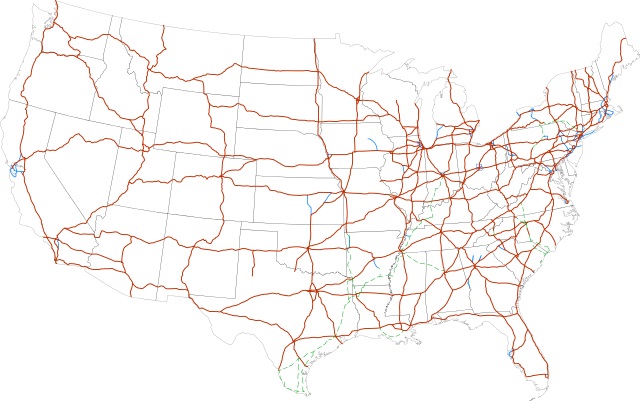
The interstate system reached 48,191 miles in 2016. Federal regulations banned collecting tolls but that would change.
“Of all his domestic programs, Eisenhower’s favorite by far was the Interstate System,” noted historian Stephen Ambrose. The thirty-fourth president urged passage of the act for national defense; interstates would be needed for evacuating major cities during a nuclear war.
_______________________
Recommended Reading: Signal Hill, California, Images of America (2006); Minnesota’s Geology (1982) Tulsa Oil Capital of the World, Images of America
(2006); Minnesota’s Geology (1982) Tulsa Oil Capital of the World, Images of America (2004); Oil in West Texas and New Mexico
(2004); Oil in West Texas and New Mexico (1982); Minnesota’s Geology (1982); Black Gold in California: The Story of California Petroleum Industry
(1982); Minnesota’s Geology (1982); Black Gold in California: The Story of California Petroleum Industry  (2016); Early California Oil: A Photographic History, 1865-1940
(2016); Early California Oil: A Photographic History, 1865-1940 (1985); Tulsa Oil Capital of the World, Images of America
(1985); Tulsa Oil Capital of the World, Images of America (2004); Oil in West Texas and New Mexico
(2004); Oil in West Texas and New Mexico (1982); Official Guide to the Smithsonian
(1982); Official Guide to the Smithsonian (2016); Eisenhower: Soldier and President
(2016); Eisenhower: Soldier and President (1968). Your Amazon purchase benefits the American Oil & Gas Historical Society. As an Amazon Associate, AOGHS earns a commission from qualifying purchases.
(1968). Your Amazon purchase benefits the American Oil & Gas Historical Society. As an Amazon Associate, AOGHS earns a commission from qualifying purchases.
_______________________
The American Oil & Gas Historical Society (AOGHS) preserves U.S. petroleum history. Please become an AOGHS annual supporter and help maintain this energy education website and expand historical research. For more information, contact bawells@aoghs.org. © 2025 Bruce A. Wells. All rights reserved.
by Bruce Wells | Apr 21, 2025 | This Week in Petroleum History
April 21, 1967 – GM celebrates its 100 Millionth Car –
General Motors celebrated its 100 millionth American-made car (a two-door Chevrolet Caprice). Founded in 1908 by William Durant, the Flint, Michigan, company began as a manufacturer of horse-drawn carriages. After leaving GM, Durant and partner Louis Chevrolet founded the Chevrolet Motor Company in 1911, which became part of GM five years later.
After World War II, GM was the first American corporation to pay more than $1 billion in taxes, according to the Detroit Historical Society, which also notes the company declared bankruptcy in 2009 and emerged less than 40 days later after a federal bailout that saved more than a million jobs. (more…)
by Bruce Wells | Apr 14, 2025 | This Week in Petroleum History
April 14, 1865 – Failed Oilman turns Assassin –
After failing to make his fortune in Pennsylvania oilfields, John Wilkes Booth assassinated President Abraham Lincoln in Washington, D.C. Booth had left his acting career a year earlier to drill an oil well in booming Venango County.
In January 1864, Booth visited Franklin, Pennsylvania, where he leased 3.5 acres on a farm, about one mile south of the village of Franklin and on the east side of the Allegheny River. With several partners, including his friends from the stage, Booth formed the Dramatic Oil Company and raised money to drill a well.
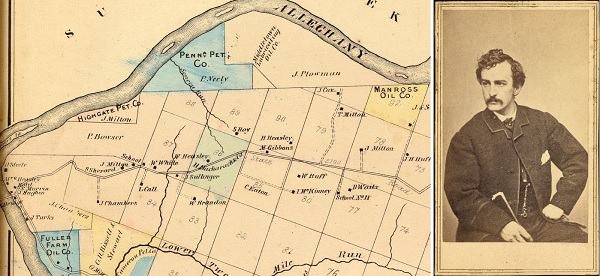
John Wilkes Booth made his first trip to the oil boom town of Franklin, Pennsylvania, in January 1864. He purchased a 3.5-acre lease on the Fuller farm (lower left). Circa 1865 photo of Booth by Alexander Gardner, courtesy Library of Congress.
Although the Dramatic Oil Company’s well found oil and began producing about 25 barrels a day, Booth and his partners wanted more and tried “shooting” the well to increase production. When the well was ruined, the failed oilman left the Pennsylvania oil region for good in July 1864.
Learn more in Dramatic Oil Company.
April 14, 1903 – Patent for Self-Heating Iron fueled by Gasoline
John Lake of Big Prairie, Ohio, received a U.S. patent (No. 725,261) for his gasoline-fueled “Self-Heating Sad Iron.” Lake had served in the 16th Ohio Volunteer Infantry Regiment during the Civil War. The ironing innovation for homes brought prosperity to his Amish community, where he established the Monitor Sad Iron Company on the Pennsylvania Railroad line. His manufacturing company made the petroleum-fueled irons for the next 50 years.
Learn more in Ironing with Gasoline.
April 15, 1857 – First Natural Gas Company incorporated
Two years before the first U.S. oil well in Titusville, Pennsylvania, the Fredonia Gas Light and Water Works Company incorporated in Fredonia, New York, where a well drilled by local machinist and gunsmith William A. Hart supplied natural gas to a mill as early as 1825. Hart found the gas after drilling three wells, according to historian Lois Barris.
“He left a broken drill in one shallow hole and abandoned a second site at a depth of forty feet because of the small volume of gas found,” Barris noted in her “Fredonia Gaslight and Waterworks Company.”
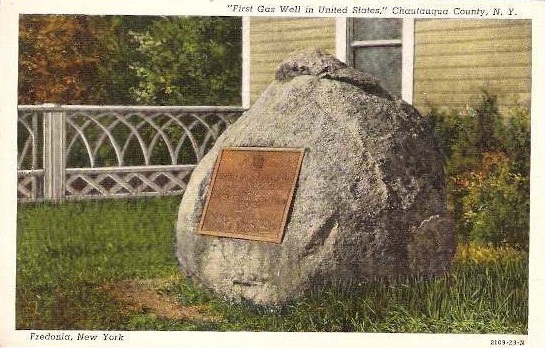
Circa 1950 souvenir postcard of a bronze plaque on a boulder in Fredonia, New York, dedicated in 1925 by the Daughters of the American Revolution.
Hart’s third well produced natural gas from 70 feet beneath a “bubbling gas spring in the bed of a creek,” Barris reported, adding that after constructing a simple gasometer, he “proceeded to pipe and market the first natural gas sold in this country.”
As other communities adopted public lighting burning gas made from coal (manufactured gas street lamps began illuminating Baltimore in 1817), Fredonia Gas Light and Water Works built the first U.S. natural gas pipeline network.

April 15, 1897 – Birth of Oklahoma Oil Industry
With a crowd gathered at the Nellie Johnstone No. 1 well near Bartlesville in Indian Territory, George Keeler’s stepdaughter dropped a “Go Devil” that set off a downhole canister of nitroglycerin. The resulting gusher heralded the start of Oklahoma’s oil and natural gas industry.
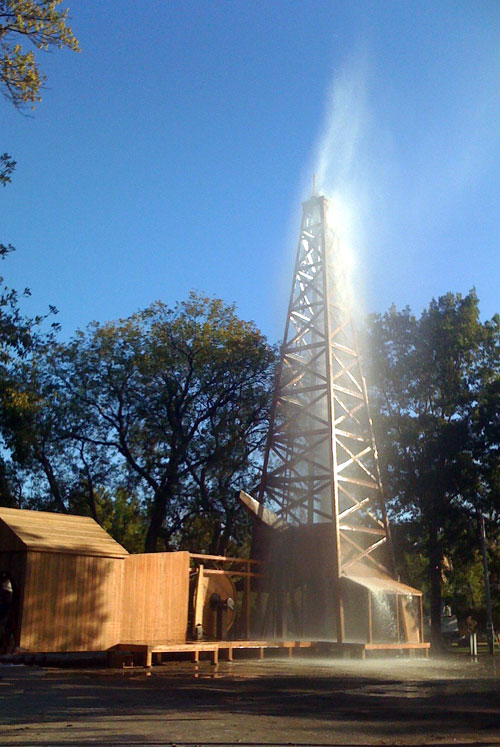
A 2017 water gusher demonstration of the Nellie Johnstone No. 1 replica in Discovery One Park, Bartlesville, Oklahoma.
Drilling had begun in January 1897, the same month that Bartlesville incorporated with a population of about 200 people. Four months later, at 1,320 feet, the Nellie Johnstone No.1 well showed its first signs of oil. There had been earlier marginal producers, including a Cherokee Nation 1890 oil well; the Johnstone well revealed the giant Bartlesville-Dewey field.
By the time of statehood in 1907, Oklahoma would lead the world in oil production. An 84-foot derrick in Discovery One Park helps educate visitors about Oklahoma’s petroleum industry. The surrounding land was donated by Nellie Johnstone Cannon, the descendant of a Delaware chief.
Learn more in First Oklahoma Oil Well.
April 16, 1855 – Scientist sees Value in “Rock Oil”
Yale chemist Benjamin Silliman Jr. reported Pennsylvania “Rock Oil” could be distilled into a high-quality illuminating oil. The professor’s “Report on Rock Oil or Petroleum” convinced a businessman George Bissell and a group of New Haven, Connecticut, investors to finance Edwin Drake to drill where Bissell had found oil seeps at a creek in northwestern Pennsylvania.
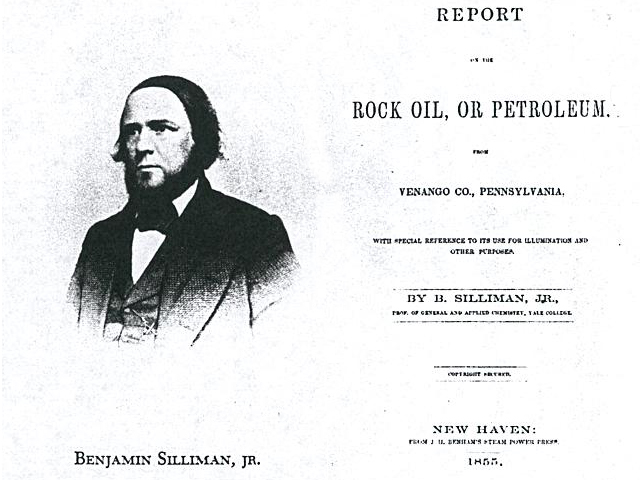
The Yale chemist’s 1855 report about oil’s potential for refining as an illuminant led to America’s first commercial well four years later.
“Gentlemen,” Silliman wrote, “it appears to me that there is much ground for encouragement in the belief that your company have in their possession a raw material from which, by simple and not expensive processes, they may manufacture very valuable products.”
Learn more in George Bissell’s Oil Seeps.
April 16, 1920 – First Arkansas Oil Well
Col. Samuel S. Hunter of the Hunter Oil Company of Shreveport, Louisiana, completed the first oil well in Arkansas. His Hunter No. 1 well had been drilled to 2,100 feet. Natural gas was discovered a few days later by Constantine Oil and Refining Company north of what would become the El Dorado field in Union County.

The Arkansas Museum of Natural Resources is just north of El Dorado.
Although Col. Hunter’s oil well yielded only small quantities, his discovery was followed by a January 1921 gusher — the S.T. Busey well — in the same field. These wells made headlines and launched the Arkansas petroleum industry, according to the Arkansas Museum of Natural Resources. Hunter later sold his original lease of 20,000 acres to the Standard Oil Company of Louisiana for more than $2.2 million.
Learn more in First Arkansas Oil Wells.

April 17, 1861 – Deadly Oil Well Fire in Pennsylvania
The lack of technologies for controlling wells led to a fatal oil well fire at Rouseville, Pennsylvania. Among the 19 people killed was leading citizen Henry Rouse, who subleased the land along Oil Creek. When his well erupted oil from a depth of 320 feet, the good news had attracted most Rouseville residents. “Henry Rouse and the others stood by wondering how to control the phenomenon,” noted the local newspaper. Then the gusher erupted into flames, perhaps ignited by a steam-engine boiler.

“Burning Oil Well at Night, near Rouseville, Pennsylvania,” a painting by James Hamilton, circa 1861, at the Smithsonian American Art Museum, Washington, D.C.
The oilfield tragedy near Titusville would be overshadowed by the Civil War, but it was immortalized in 1861 by Philadelphia artist James Hamilton’s “Burning Oil Well at Night, near Rouseville, Pennsylvania,” which was added to the Smithsonian American Art Museum collection in 2017.
Learn more in Fatal 1861 Rouseville Oil Well Fire.
April 17, 1919 – North Texas Burkburnett Boom grows
Yet another drilling boom began in Wichita County, Texas, when the Bob Waggoner Well No. 1 well began producing 4,800 barrels of oil a day — extending to the northwest a 1918 oilfield found on the Burkburnett farm of S.L. Fowler. Wichita County had been producing oil since the 1911 discovery of the Electra oilfield.
At Burkburnett, a 2006 historical marker of the Texas Historical Commission notes the 1919 discovery “became known as the Northwest Extension Oilfield, comprised of approximately 27 square miles on the former S. Burk Burnett Wild Horse Ranch.” The marker adds “the area was suddenly thick with oil derricks” thanks to the oilfield discoveries that created the boom town Burkburnett.
April 18, 1939 – Patent for perforating Well Casing
Ira McCullough of Los Angeles patented a multiple bullet-shot casing perforator and mechanical firing system. He explained the object of his oilfield invention was “to provide a device for perforating casing after it has been installed in a well in which projectiles or perforating elements are shot through the casing and into the formation.”
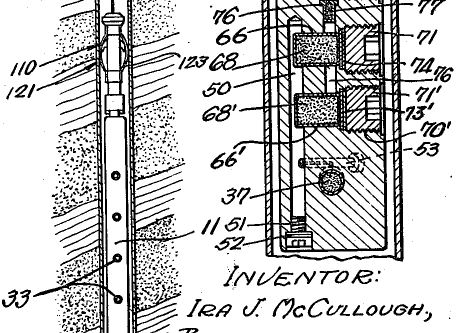
Ira McCullough’s 1937 patent drawing for perforating wells.
The innovation of simultaneous firing from several levels in the borehole greatly enhanced the flow of oil. McCullough’s device included a “disconnectable means” that rendered percussion inoperative until the charges were lowered into the borehole, acting as “a safeguard against accidental or inadvertent operation.”
Another inventor, Henry Mohaupt, in 1951 used anti-tank technology from World War II to improve the concept by using a conically hollowed-out explosive for perforating wells.
Learn more in Downhole Bazooka.
April 19, 1892 – First U.S. Gasoline Powered Automobile
Brothers Charles and Frank Duryea test drove a gasoline-powered automobile they had built in their Springfield, Massachusetts, workshop. Considered the first model to be regularly manufactured for sale in the United States, 13 were produced by the Duryea Motor Wagon Company.

The Duryea brothers (above) built their pioneering autos in Springfield, Massachusetts.
The brothers sold their first Duryea motor wagon in March 1918. Two months later, a motorist driving a Duryea in New York City hit a bicyclist — reportedly America’s first auto traffic accident. By the time of the first U.S. automobile show in November 1900 at Madison Square Garden, of the 4,200 automobiles sold in the United States, gasoline powers less than 1,000.

April 20, 1875 – Improved Well Pumping Technology
Pumping multiple wells with a single steam engine boosted efficiency in early oilfields when Albert Nickerson and Levi Streeter of Venango County, Pennsylvania, patented their “Improvement In Means For Pumping Wells.” The new technology used a system of linked and balanced walking beams to pump oil wells.

U.S. oilfield technologies advanced in 1875 with an “Improvement In Means For Pumping Wells.”
“By an examination of the drawing it will be seen that the walking-beam to well No. l is lifting or raising fluid from the well. Well No. 3 is also lifting, while at the same time wells 2 and 4 are moving in an opposite direction, or plunging, and vice versa,” the inventors explained. Their system was the forerunner of rod-line (or jerk-line) eccentric wheel systems that operated into the 20th century using iron rods instead of rope and pulleys.
Learn more in All Pumped Up – Oilfield Technology.
April 20, 1892 – Prospector discovers Los Angeles City Oilfield
The giant Los Angeles oilfield was discovered when a struggling prospector, Edward Doheny, and his mining partner Charles Canfield drilled into the tar seeps between Beverly Boulevard and Colton Avenue. Their well produced about 45 barrels of oil a day.

Artfully camouflaged petroleum production continues today in downtown Los Angeles. Edward Doheny discovered the oilfield in 1892. Photo courtesy the Center for Land Use Interpretation, Culver City, California.
Although the first California oil well had been drilled after the Civil War, Doheny’s 1892 discovery near present-day Dodger Stadium launched California’s petroleum industry. In 1897, about 500 Los Angeles City wells pumped more than half of the state’s annual production of 1.2 million barrels of oil. By 1925, California supplied half of all the world’s oil.
Learn more in Discovering Los Angeles Oilfields.
April 20, 2010 – Deepwater Horizon Gulf of Mexico Disaster
At 10 a.m., while completing a well in the Macondo Prospect, 50 miles off the Louisiana coast, the Deepwater Horizon exploded and sank, killing 11 and injuring another 17 workers. An estimated 3.2 million barrels of oil flowed into the Gulf of Mexico after the platform’s 400-ton blowout preventer failed, resulting in the largest accidental marine oil spill in U.S. history.
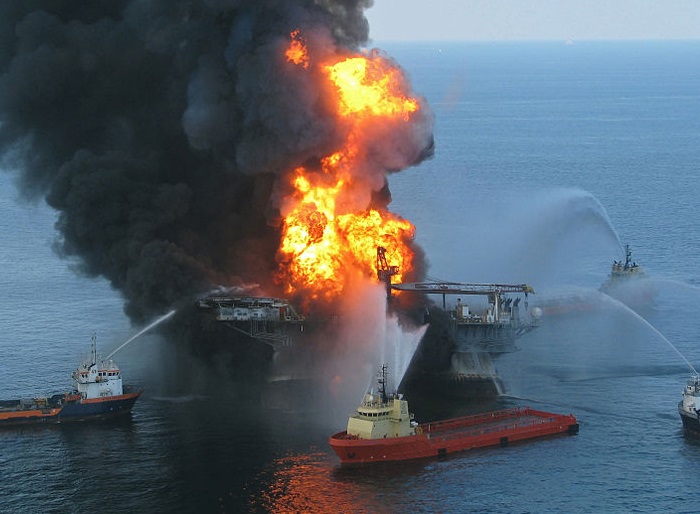
The April 2010 Deepwater Horizon explosion and fire killed 11 and injured 17 workers. USGS Photo.
Six months earlier at another site, the advanced, semi-submersible drilling rig had set a world record for the deepest offshore well (35,050 feet vertical depth in 4,130 feet of water). When the Macondo Prospect well was capped in mid-July, a National Commission on the Deepwater Horizon Oil Spill and Offshore Drilling launched an eight-month investigation. The commission released its final report on January 11, 2011.
_______________________
Recommended Reading: Recommended Reading: Sketches in Crude-Oil (1902); Myth, Legend, Reality: Edwin Laurentine Drake and the Early Oil Industry (2009); The Extraction State, A History of Natural Gas in America (2021); Oil in Oklahoma
(2009); The Extraction State, A History of Natural Gas in America (2021); Oil in Oklahoma (1976); Early Louisiana and Arkansas Oil: A Photographic History, 1901-1946
(1976); Early Louisiana and Arkansas Oil: A Photographic History, 1901-1946 (1982); Cherry Run Valley: Plumer, Pithole, and Oil City, Pennsylvania (2000); Early Texas Oil: A Photographic History, 1866-1936
(1982); Cherry Run Valley: Plumer, Pithole, and Oil City, Pennsylvania (2000); Early Texas Oil: A Photographic History, 1866-1936 (2000); Wireline: A History of the Well Logging and Perforating Business in the Oil Fields
(2000); Wireline: A History of the Well Logging and Perforating Business in the Oil Fields (1990); Dark Side of Fortune: Triumph and Scandal in the Life of Oil Tycoon Edward L. Doheny (2001); Deep Water: The Gulf Oil Disaster and the Future of Offshore Drilling: Report to the President
(1990); Dark Side of Fortune: Triumph and Scandal in the Life of Oil Tycoon Edward L. Doheny (2001); Deep Water: The Gulf Oil Disaster and the Future of Offshore Drilling: Report to the President (2011). Your Amazon purchase benefits the American Oil & Gas Historical Society. As an Amazon Associate, AOGHS earns a commission from qualifying purchases.
(2011). Your Amazon purchase benefits the American Oil & Gas Historical Society. As an Amazon Associate, AOGHS earns a commission from qualifying purchases.
_______________________
The American Oil & Gas Historical Society (AOGHS) preserves U.S. petroleum history. Please become an AOGHS annual supporter and help maintain this energy education website and expand historical research. For more information, contact bawells@aoghs.org. Copyright © 2025 Bruce A. Wells. All rights reserved.
by Bruce Wells | Jul 15, 2020 | AOGHS Newsletter






(2000); The Discovery of Oil in South Arkansas, 1920-1924 (1974); Historic Battleship Texas: The Last Dreadnought
(2007); Evolution of the American Diesel Locomotive, Railroads Past and Present
(2007); Early Texas Oil: A Photographic History, 1866-1936
(2000) Death and Oil: A True Story of the Piper Alpha Disaster on the North Sea
(2011). Your Amazon purchase benefits the American Oil & Gas Historical Society. As an Amazon Associate, AOGHS earns a commission from qualifying purchases.






















